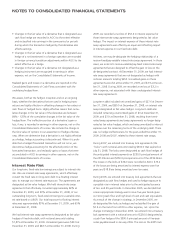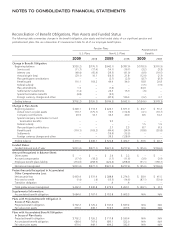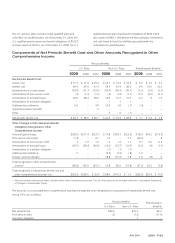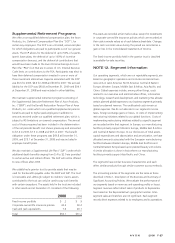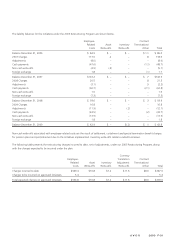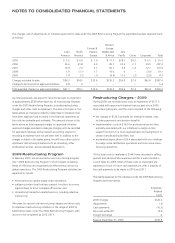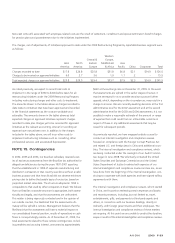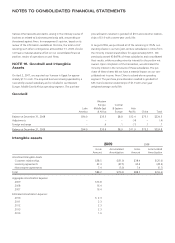Avon 2009 Annual Report Download - page 90
Download and view the complete annual report
Please find page 90 of the 2009 Avon annual report below. You can navigate through the pages in the report by either clicking on the pages listed below, or by using the keyword search tool below to find specific information within the annual report.
NOTES TO CONSOLIDATED FINANCIAL STATEMENTS
Areconciliation of the beginning and ending balances for our
Level 3investments was as follows:
Amount
Balance as of January 1, 2009 $14.9
Actual return on plan assets held (1.0)
Foreign currency changes .3
Balance as of December 31, 2009 $14.2
Investments in equity securities classified as Level 1inthe fair
value hierarchy are valued at quoted market prices. Investments in
equity securities classified as Level 2inthe fair value hierarchy are
valued at quoted market prices for non-active securities. Fixed
income securities are based on broker quotes for non-active
securities. Mutual funds are valued at quoted market prices. Real
estate is valued by reference to investment and letting transact-
ions at similar types of property and are supplemented by third
party surveyors.
The overall objective of our U.S. pension plan is to provide the
means to pay benefits to participants and their beneficiaries in
the amounts and at the times called for by the plan. This is
expected to be achieved through the investment of our contri-
butions and other trust assets and by utilizing investment policies
designed to achieve adequate funding over areasonable period
of time.
Pension trust assets are invested so as to achieve areturn on
investment, based on levels of liquidity and investment risk that
is prudent and reasonable as circumstances change from time to
time. While we recognize the importance of the preservation of
capital, we also adhere to the theory of capital market pricing
which maintains that varying degrees of investment risk should
be rewarded with compensating returns. Consequently, prudent
risk-taking is justifiable.
The asset allocation decision includes consideration of the non-
investment aspects of the Avon Products, Inc. Personal Retire-
ment Account Plan, including future retirements, lump-sum elec-
tions, growth in the number of participants, company contri-
butions, and cash flow. These actual characteristics of the plan
place certain demands upon the level, risk, and required growth
of trust assets. We regularly conduct analyses of the plan’s cur-
rent and likely future financial status by forecasting assets, liabili-
ties, benefits and company contributions over time. In so doing,
the impact of alternative investment policies upon the plan’s
financial status is measured and an asset mix which balances
asset returns and risk is selected.
Our decision with regard to asset mix is reviewed periodically.
Asset mix guidelines include target allocations and permissible
ranges for each asset category. Assets are monitored on an
ongoing basis and rebalanced as required to maintain an asset
mix within the permissible ranges. The guidelines will change
from time to time, based on an ongoing evaluation of the plan’s
tolerance of investment risk.
Cash flows
We expect to make contributions in the range of $15 to $20 to
our U.S. pension and postretirement plans and in the range of
$30 to $40 to our international pension and postretirement
plans during 2010.
Total benefit payments expected to be paid from the plans are
as follows:
Pension Benefits
U.S.
Plans
Non-U.S.
Plans Total
Postretirement
Benefits
2010 $69.3 $39.4 $108.7 $11.4
2011 60.0 40.2 100.2 11.3
2012 83.0 40.8 123.8 11.1
2013 62.8 43.1 105.9 9.7
2014 60.8 43.7 104.5 9.6
2015 –2019 295.6 237.9 533.5 46.2
Postretirement Benefits
For 2009, the assumed rate of future increases in the per capita
cost of health care benefits (the health care cost trend rate) was
8.0% for all claims and will gradually decrease each year thereafter
to 5.0% in 2017 and beyond for our U.S. plan. Aone-percentage
point change in the assumed health care cost trend rates for all
postretirement plans would have the following effects:
1Percentage
Point Increase
1Percentage
Point Decrease
Effect on total of service and
interest cost components $.3$(.2)
Effect on postretirement
benefit obligation 2.8 (2.5)
Postemployment Benefits
We provide postemployment benefits, which include salary con-
tinuation, severance benefits, disability benefits, continuation of
health care benefits and life insurance coverage to eligible former
employees after employment but before retirement. The accrued
cost for postemployment benefits was $67.2 at December 31,
2009 and $74.9 at December 31, 2008, and was included in
employee benefit plans liability.


